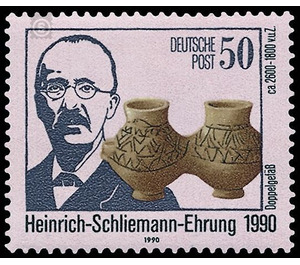100th anniversary of death of Heinrich Schliemann - Germany / German Democratic Republic 1990 - 50 Pfennig
Theme: Calender
| Country | Germany / German Democratic Republic |
| Issue Date | 1990 |
| Face Value | 50.00 |
| Color | pink |
| Perforation | K 14 |
| Printing Type | Rotogravure 2 |
| Stamp Type | Postage stamp |
| Item Type | Stamp |
| Chronological Issue Number | 3107 |
| Chronological Chapter | GER-DDR |
| SID | 820604 |
| In 20 Wishlists | |
Heinrich Schliemann Award 1990 For the Heinrich Schliemann Award 1990, the Ministry of Posts and Telecommunications of the GDR issued two multicolored special postage stamps. Special cancellation from 2 October to 1 December 1990 Heinrich Schliemann honor 1990 On the occasion of the 100th anniversary of the death of the German archaeologist Heinrich Schliemann, world-famous for his excavations in Troy, Mycenae, Tiryns and Orchomenos, honors are held all over the world, as well his closer home in Neubukow, Ankershagen and especially in Berlin. Heinrich Schliemann was born on January 6, 1822 in Neubukow near Wismar as the son of a pastor. He spent his childhood in Mecklenburg. After five years as a salesman in a grocer in Fürstenberg, he moved into the world to find his happiness. After a shipwreck off Holland, he was employed in Amsterdam in a trading house and in 1846 as an agent of this company in St. Petersburg, where he obtained a year later, self-employment. By happy business deals, especially by speculation during the Crimean War, he was very rich and could devote his interests in the second half of his life. After extensive travels around the world and learning of nearly twenty languages, he liquidated his trading company in 1866, studied in Paris, acquired in 1869 the doctorate of the University of Rostock and turned entirely to archeology. Convinced that Homer portrayed historical events in his epics "Iliad" and "Odyssey", in 1870 he began excavating a princely seat in Wastanatolia on the hill Wissarlik, which is generally accepted as the legendary Troy, into which Paris abducted beautiful Helen and around which the Greeks under Agamemnon of Mycenae fought for ten years. In 1873 he found there a rich gold treasure, which he called the "Treasure of Priam". The excavations in Troy continued Schliemann until 1890. In 1876 he succeeded in the sensational discovery of the grave round in the castle of Mycenae, from the immeasurable gold jewelry, including the so-called "Mask of Agamemnon", was salvaged. With further excavations in Orchomenos and the castle of Tiryns in 1884, he pointed to the Mycenaean culture, which was 1000 years before classical antiquity. Heinrich Schliemann donated his Trojan finds to the Royal Museums in Berlin and in 1881 received the honorary citizenship of the city. Although Schliemann erred in some respects, he acquired lasting service in the field of archeology. He was one of the first to use modern excavation methods. He also succeeded in the chronology of Aegean space, which is still valid today. He is therefore rightly called "pioneer of prehistory and early history" and "father of the Mycenaean culture" and enjoys international recognition. Since 1958, the Museum of Prehistoric and Protohistoric History of the Berlin State Museums has been responsible for a large part of Troy's status, which had been saved during World War II. Together with the Archaeological National Museum in Athens, which possesses the finds of the Greek mainland, it shows for the first time in the world selected pieces from all world-famous places that Heinrich Schliemann excavated. On October 2, 1990, this joint exhibition will be opened in the Altes Museum in Berlin. Underneath are the two vessels shown here. The 50 Pfennig brand shows Schliemann as a scientist at the height of his fame in the 80s. Before him the representation of a double feet in the form of two small amphorae. It dates from Troy II-V, Bronze Age (circa 2600-1800 BCE) and was probably used for ritual purposes.


